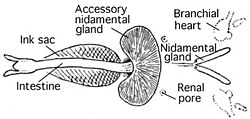Branchial heart

Branchial hearts are accessory pumps that supplement the action of the systemic heart in a cephalopod's body. They are myogenic in nature.[1] Branchial hearts are always in pairs located at the base of the gills. Each branchial heart consists of a single chamber.[1][2] They pump blood through the gills via the afferent branchial veins. Since they only circulate venous blood, branchial hearts function under predominantly anaerobic conditions.[1] Branchial hearts also appear to be involved in hemocyanin synthesis.[3][2]
Each branchial heart is directly connected to a branchial heart appendage or pericardial gland.[4] The action of the branchial hearts is necessary for the production of primary urine in these appendages via pressure filtration.[5] Branchial hearts may have evolved from the pericardial glands of nautiloids, such as those still found in modern nautiluses.[6]
References[]
- ^ a b c Fiedler, A.; Schipp, R. (1987). "The role of the branchial heart complex in circulation of coleoid cephalopods". Experientia. 43 (5): 544–553. doi:10.1007/BF02143583. S2CID 3165383.
- ^ a b Cephalopoda Glossary. Tree of Life web project.
- ^ Beuerlein, K.; Schimmelpfennig, Robert; Westermann, Bettina; Ruth, Peter; Schipp, Rudolf (1998). "Cytobiological studies on hemocyanin metabolism in the branchial heart complex of the common cuttlefish Sepia officinalis (Cephalopoda, Dibranchiata)". Cell and Tissue Research. 292 (3): 587–595. doi:10.1007/s004410051088. PMID 9582416. S2CID 33065779.
- ^ Witmer, Astrid; Martin, Arthur W. (1973). "The fine structure of the branchial heart appendage of the cephalopod Octopus dofleini martini". Zeitschrift für Zellforschung und Mikroskopische Anatomie. 136 (4): 545–68. doi:10.1007/BF00307370. PMID 4346672. S2CID 27050110.
- ^ Schipp, R.; Schmidt, H. R.; Fiedler, A. (1986). "Comparative cytochemical and pharmacological studies on the cholinergic innervation of the branchial heart of the cephalopod Sepia officinalis (L.)". Experientia. 42: 23–30. doi:10.1007/BF01975878. S2CID 19161306.
- ^ Bourne, G. B.; Redmond, J. R.; Johansen, K. (1977). "Nautilus pompilius: branchial circulation enhanced by an auxiliary pumping mechanism". Experientia. 33 (11): 1453. doi:10.1007/BF01918802. S2CID 33164113.
- Cardiology
- Cephalopod zootomy
- Cephalopod stubs


